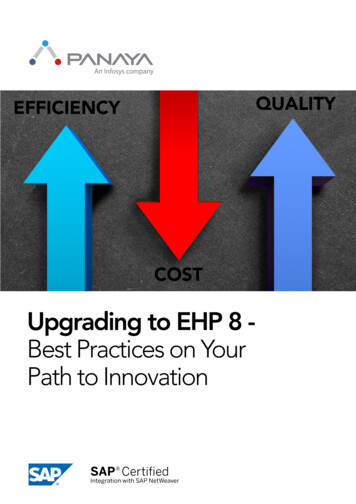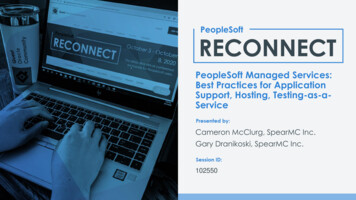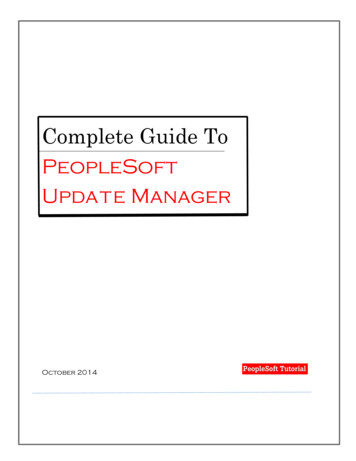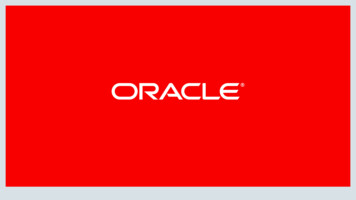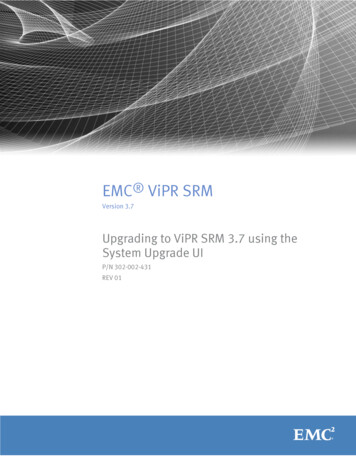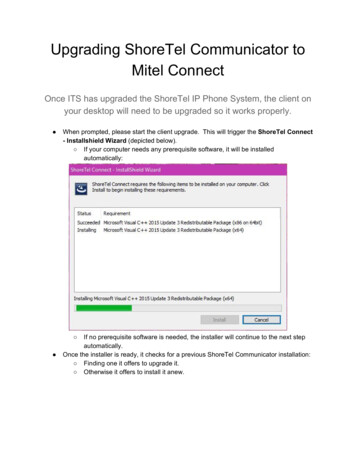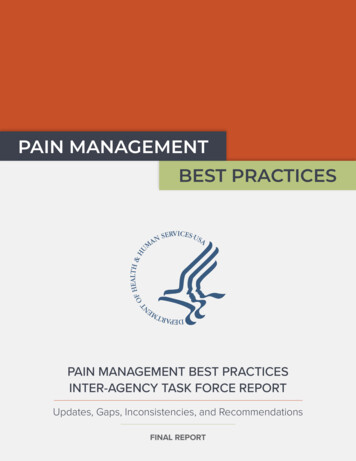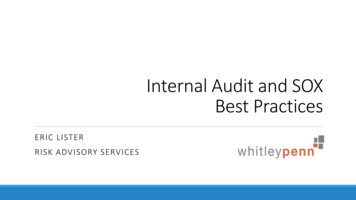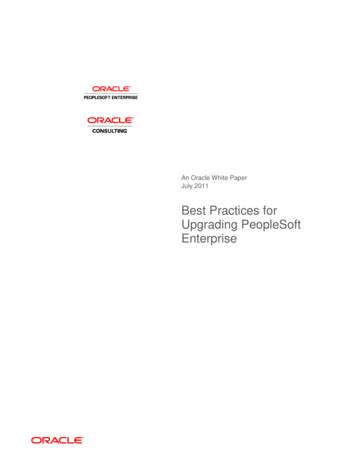
Transcription
An Oracle White PaperJuly 2011Best Practices forUpgrading PeopleSoftEnterprise
Best Practices for Upgrading PeopleSoft EnterpriseIntroduction . 3Upgrade Overview . 4The Upgrade Process . 4Initial Pass . 5Test Move to Production Pass . 5Final Move to Production Pass . 5Examining Your Upgrade Criteria. 5Application Functionality . 5Technological Enhancements . 6Operational Considerations. 6Support Availability . 7Identifying Your Upgrade Path . 7Customers on PeopleSoft Enterprise HCM 8.9 and Later . 8Customers on PeopleSoft Enterprise FMS/SCM (Financials/SupplyChain) 8.9 and Later . 9Customers on PeopleSoft Enterprise CRM 8.9 and Later . 9Customers on PeopleSoft Enterprise EPM 8.9 and Later . 10Customers on PeopleSoft Enterprise ELM 8.9 and Later . 11Upgrade Best Practices . 12General Recommendations . 12Project Initiation Considerations . 16Preparing Your Technical Environment . 18Installing Your New Release . 20Upgrading Your Data . 21Training. 22Post-Upgrade Activities . 23Upgrade Tools . 24Oracle Fusion . 25Additional Resources . 25Conclusion . 25Best Practices for Upgrading Peoplesoft EnterprisePage 2
Best Practices for Upgrading PeopleSoft EnterpriseIntroductionAs part of Oracle’s commitment toApplications Unlimited, PeopleSoftEnterprise continues to evolve, offeringgreater value and providing newadvantages for your business. UpgradingPeopleSoft Enterprise is key to realizingthe maximum return on your Oracleinvestment.Oracle’s PeopleSoft Enterprise applications have evolved over time, and Oracle’scommitment to customers, this suite of applications, and creating best-in-classproducts remains steadfast. The PeopleSoft Enterprise product has expandedsignificantly in functionality, scalability, usability, and reduced cost of ownershipover the past few releases, including significant leaps made in the recent PeopleSoftEnterprise 9.1 Feature Pack release.This white paper guides you through the major areas to consider in determiningwhen an upgrade is appropriate for your organization. Based on your currentrelease of PeopleSoft Enterprise software, it reviews the most common upgradepaths and aims to provide you with a framework for determining the best possibleupgrade agenda for your organization. Furthermore, it also includes informationabout future upgrade options to the next generation of application softwarecurrently branded as Oracle Fusion Applications. Combined, ApplicationsUnlimited and Oracle Fusion Applications give you the flexibility that you need increating an upgrade plan that maximizes the value of your PeopleSoft Enterpriseinvestment.There are many reasons to consider upgrading. For example: Upgrading may provide access to new functionality and software applicationsthat can help keep your organization well positioned to meet your businessobjectives through leveraging the latest technology In an increasingly rigorous regulatory compliance environment, upgradingmay facilitate compliance at a lower cost through retiring customizations anddeploying standard processes across your organization Upgrading will allow you to leverage the latest performance and usabilityenhancements, enabling you to increase the efficiency of your applicationsand your business You may need to upgrade to remain eligible for the highest levels of productsupportIn evaluating any upgrade, there are many factors to consider such as support timeframes, functional capabilities, technical infrastructure, and underlying businessneeds. These factors are often complex and interrelated—all of which adds to theimportance of determining the most appropriate upgrade strategy.To help you make an informed decision, this paper outlines our plans forsupporting and advancing PeopleSoft Enterprise as well as its successor, OracleFusion Applications.Best Practices for Upgrading Peoplesoft EnterprisePage 3
Upgrade OverviewAlthough an upgrade project is similar toan implementation project, the upgradeproject can be significantly more efficientBefore pursuing an upgrade, it is imperative that you fully understand the upgradeprocess, potential upgrade paths, and most importantly your criteria for consideringan upgrade of your PeopleSoft Enterprise solution.because it leverages your previousimplementation efforts and outputs.The Upgrade ProcessAn upgrade project is in many respects similar to an implementation project;however, upgrade projects can be significantly more efficient than implementationsbecause they leverage your previous implementation efforts and outputs. Inaddition, upgrades can be executed within the current change management systemused by your organization.Within the upgrade project, there are several key areas of work that begin withproject definition and continue through the training of personnel on the newsolution.The following graphic presents the standard upgrade process at a high level:The three major technical phases to a standard upgrade project include:1.The Initial Pass2.The Test Move to Production Pass(es)Best Practices for Upgrading Peoplesoft EnterprisePage 4
3.The compare between the New Releaseand Copy of Production is performedduring the Initial Pass only. The degree ofanalysis that follows the compare dependson the number and complexity ofcustomizations in the Copy of Production.In the Move to Production passes, thecompare and analysis steps are replacedby export and import scripts that moreThe Final Move to Production PassInitial PassThe first pass is called the ―Initial Pass.‖ In this pass, you create a copy of yourproduction database referred to as the ―Copy of Production.‖ You then install theDemo database, delivered with the new PeopleSoft product release. With thecompare analysis complete, the new release is incorporated into the Copy ofProduction to create the first ―Upgraded Copy of Production.‖ In the Initial Pass,the Demo database is the Source for all new release objects and system data, andthe Copy of Production is the Target.efficiently incorporate the new releasemodified objects from the Upgraded Copyof Production into your New Copy ofProduction.Test Move to Production PassAfter completing the Initial Pass, you begin a series of ―Test Move to ProductionPasses.‖ In these passes, you create a new copy of your production database calledthe ―New Copy of Production.‖ Using the Upgraded Copy of Production as theSource for all new release objects and system data, the new release is incorporatedinto the New Copy of Production to create a new ―Upgraded Copy of Production.‖In the Test Move to Production Passes, each iterative New Copy of Production isthe Target.Repeat the Test Move to Production Pass until you are comfortable with the outputof your functional business decisions and the pass runs smoothly against a currentcopy of your production database. Create an updated New Copy of Productionbased on your most recent production data for each pass.Final Move to Production PassWhen you are ready for the ―Final Move to Production Pass,‖ you freeze theproduction database and the new release is incorporated into the productiondatabase itself. In this Final Move to Production Pass, the most recent successfuloutput of the Test Move to Production Pass (the Upgraded Copy of Production) isthe Source and the production database is the Target.Examining Your Upgrade CriteriaThere are several areas to consider as you examine your upgrade options includingapplication functionality, technological enhancements, operational considerations,and support availability.Application FunctionalityWhen considering an upgrade, most organizations begin with a critical assessmentof the new capabilities and enhancements to current features provided in the newrelease. A firm grasp of these new capabilities and enhancements is essential toevaluating the value to be gained through your organization’s investment of timeand resources.Best Practices for Upgrading Peoplesoft EnterprisePage 5
In many instances, new capabilities can offer several productivity advantages;increased business value and lower operational costs (for example, throughretirement of customizations). In evaluating any new PeopleSoft Enterprise release,think about your current environment and whether the version in place meets theneeds of today as well as the demands of your business for the next three to fiveyears.Release notes are the best starting pointfor reviewing the technical upgraderequirements.Release notes are the best first step to understanding the major changes included inthe new release. Also, these documents provide valuable references to otherdocumentation that can help guide you in evaluating and implementing the newrelease into your organization. This information is found on the My Oracle Supportweb site for HCM, FSCM, CRM, ELM, EPM and Portal applicationsYour Oracle Consulting or Application Sales Manager can help you identify newfeatures, functionality, and processes that may provide value to your organization.Technological EnhancementsPeopleSoft Enterprise 9 User ProductivityKit content can save significant time andeffort when analyzing business processenhancements. Once the upgrade projectis underway, the same content can beleveraged again to efficiently manage testscript and training plan creation.As you evolve your application upgrade strategy, you should consider yourtechnical infrastructure requirements, including client architecture, applicationserver, Web services, and database options. Consider what has changed and whatwill change in terms of platform support, and also be aware of infrastructureenhancements that may provide additional benefits to your productionenvironments. For example, by choosing to leverage current Oracle FusionMiddleware and database options, you could experience substantial benefits byhaving your database and application server running on a single platform.PeopleSoft Enterprise has traditionally afforded several choices of technicalinfrastructure, and this flexibility continues to be available. In the past year, weexpanded the choices again, with the additional infrastructure option of OracleFusion Middleware for your PeopleSoft applications.Oracle’s industry-leading Lifetime Support Policy of your infrastructureconfiguration is well documented in the document Lifetime Support Policy: Coverage forApplications and Server Technologies. Regardless, you should always confirm yourspecific infrastructure components when preparing for your upgrade.Operational ConsiderationsOracle continually seeks to improve your return on investment by leveragingtechnology to reduce the resources required to operate and maintain yourenterprise solutions. This means customers like you can install and implementsoftware more quickly, simplify upgrades, receive real-time support andperformance diagnostics, and achieve robust integration with other e-businesssoftware—delivering quantifiable benefits.The PeopleSoft Enterprise 9.1 release takes these benefits to the next level. Oraclecontinues to deliver improvements that will further reduce implementation costs,enhance usability, and increase supportability.Best Practices for Upgrading Peoplesoft EnterprisePage 6
If you are running multiple instances of thePeopleSoft application, your upgradeanalysis should examine the value ofincorporating instance consolidation intothe upgrade project.For organizations running on more than one instance of PeopleSoft, the cost, risk,and operational value of instance consolidation should be included in your upgradevalue analysis.Support AvailabilityA key reason for pursuing upgrades is to ensure continued access to the robusttechnical support that PeopleSoft application users have come to expect. As part ofour Applications Unlimited commitment to our customers, Oracle providescontinued enhancements to the current Oracle applications beyond the delivery ofOracle Fusion. Oracle is committed to supporting customer investments intechnology platforms for these applications as well as their certified infrastructureproducts (hardware, operating systems, databases, and middleware). Details can beaccessed at the following location: me-support-policy-datasheet.pdf.With the guaranteed support announced through the Oracle Lifetime Supportinitiative, Oracle customers can remain on their PeopleSoft Enterprise applicationsand be confident of support as long as they remain aligned with the currentlysupported platforms. Oracle is providing more visibility into product roadmaps,and is helping customers derive continual success from their current applications bydelivering dedicated, world-class development and support for years to come.When examining your infrastructure support availability, be sure to include ananalysis of your hardware and operating system end of life support dates, if any.Identifying Your Upgrade PathIn addition to the factors just discussed, you may also want to consider the amountof time needed to upgrade and ensure you will have the full support and coveragefor your solution. The timing of the release availability should not significantly alteryour upgrade plans; instead, as mentioned above, your upgrade decision should bebased on the ability of your currently deployed release to support your business inthe near-to-medium term.It is important to note that Oracle Fusion will evolve as an optional ―path‖ to thefuture, rather than a ―destination‖ because your PeopleSoft Enterprise solution willcontinue to evolve over time adopting Oracle Fusion technologies as they becomeavailable. Portions of Oracle Fusion technology are already partially available in thenew PeopleSoft Enterprise 9.1 releases as well as planned into the future releases ofPeopleSoft Enterprise applications.Whether or not you are planning to upgrade to Oracle Fusion Applications in thenext few years, you should still factor the upgrade path to Oracle FusionApplications into your plans in order to minimize your future cost and risk shouldyou later discover that this next-generation product suite best satisfies yourevolving business objectives. Based on customer feedback, Oracle is planning todeliver processes to upgrade directly to Oracle Fusion Applications fromBest Practices for Upgrading Peoplesoft EnterprisePage 7
PeopleSoft Enterprise 8.8 and later releases. In short, while the business benefits ofrunning on Oracle Fusion Applications may be substantial, upgrades to OracleFusion will be entirely optional given the continued commitment of ApplicationsUnlimited, and your own unique business objectives. Still, as needs change rapidlyin today’s dynamic business environment, it is wise to position yourself for thegreatest flexibility in your future upgrade options.The following sections show examples of upgrade paths for each release ofPeopleSoft Enterprise software. We expect that customers will be on these releasesfor several years, and we have therefore created a general set of recommendedupgrade paths. While each situation is unique, the upgrade path recommendationsshould assist in providing you with a basic framework for discussion with yourOracle account representative.Customers on PeopleSoft Enterprise HCM 8.9 and LaterCustomers on PeopleSoft Enterprise HCM 8.9 or later releases will have fullsupport including access to newly created patches and fixes, upgrade scripts to themost current software release. As of this document the PeopleSoft EnterpriseUpgrade Guides have been released on the My Oracle Support Web site for yourreview and assessment:Find your specific link and review the processes and documents required toupgrade your organization to the latest Release of Software. For HCM there is anEnterprise PeopleSoft HCM 9.1 Information Center link for additional help.Here is a quick glance of the supported upgrade paths available to PeopleSoftEnterprise HCM 9.1 Feature Pack. Upgrading from PeopleSoft Enterprise HCM 9.0 to PeopleSoft EnterpriseHCM 9.1 Feature Pack. Upgrading from PeopleSoft Enterprise HCM 8.9 MP 1 to PeopleSoftEnterprise HCM 9.1 Feature Pack. Upgrading from PeopleSoft Enterprise HCM 8.8x to PeopleSoft EnterpriseHCM and PeopleSoft Enterprise Campus Solutions 9.0 Maintenance Pack 5. Upgrading from PeopleSoft Enterprise Learning Solutions 8 SP1 toPeopleSoft Enterprise HCM and PeopleSoft Enterprise Campus Solutions 9Maintenance Pack 5 (Note this is a double step path 8 SP1 – 8.9 / 8.9 –9.0MP5). Upgrading from PeopleSoft Enterprise HCM 8.8x to PeopleSoft EnterpriseHCM and PeopleSoft Enterprise Campus Solutions 9.1 Feature Pack,including Pay/Bill ManagementRemember to periodically check the My Oracle Support Web site as Oracle updatesthese files on an ongoing basis.Best Practices for Upgrading Peoplesoft EnterprisePage 8
Customers on PeopleSoft Enterprise FMS/SCM (Financials/Supply Chain) 8.9and LaterCustomers on PeopleSoft Enterprise FMS/SCM (including ALM, ESA, and SRMapplications) 8.9 or later releases will have full support including access to newlycreated patches and fixes, upgrade scripts to the most current software release. Asof this document the PeopleSoft Enterprise Upgrade Guides have been released onthe My Oracle Support Web site for your review and assessment:Find your specific link and review the processes and documents required toupgrade your organization to the latest Release of Software. For FSCM there is anEnterprise PeopleSoft FSCM 9.1 Information Center link for additional help.Find your specific link and review the processes and documents required toupgrade your organization to the latest Release of Software.Here is a quick glance of the supported upgrade paths available to PeopleSoftEnterprise FMS/SCM 9.1 Feature Pack. Upgrading from PeopleSoft Enterprise FMS/SCM 9.0 to PeopleSoftEnterprise FMS/SCM 9.1 Feature Pack. Upgrading from PeopleSoft Enterprise FMS/SCM 8.9 to PeopleSoftEnterprise FMS/SCM 9.1 Feature Pack. Upgrading from PeopleSoft Enterprise FMS/SCM 8.8x to PeopleSoftEnterprise FMS/SCM 9.1 Feature Pack. Upgrading from PeopleSoft Enterprise FMS/SCM 8.4x to PeopleSoftEnterprise FMS/SCM 9.1 Feature Pack. (Note this is a double step path 8.4 –9.0MP5 / 9.0 – 9.1FP). Upgrading from PeopleSoft Enterprise Staffing Front Office 8.8 andFMS/SCM
Demo database, delivered with the new PeopleSoft product release. With the compare analysis complete, the new release is incorporated into the Copy of Production to create the first ―Upgraded Copy of Production.‖ In the Initial Pass,File Size: 358KB
